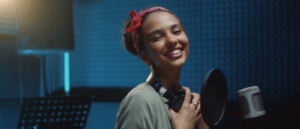
In the realm of visual storytelling, the perfect marriage between music and visuals can elevate the impact and emotional resonance of your content. With a vast library of royalty free music at your disposal, finding the right tracks that seamlessly synchronize with your visuals is an art form in itself. In this blog post, we’ll explore the art of syncing and provide you with valuable tips to master the skill of matching royalty free music to visuals.
Before diving into the vast selection of royalty free music, it’s crucial to have a clear understanding of the mood and narrative of your visuals. Consider the emotions you want to evoke and the story you want to convey. Are you aiming for an upbeat and energetic vibe or a more contemplative and introspective mood? Knowing your desired tone will help guide your music selection process.
The tempo and rhythm of the music greatly impact the pacing and energy of your visuals. If you have fast-paced action shots or dynamic movements, selecting music with a higher tempo can amplify the intensity. Conversely, if you have slower, more serene scenes, choosing music with a slower tempo can enhance the tranquility and introspection.
Music has its own language of dynamics, with soft and gentle moments contrasting with powerful crescendos. Look for tracks that offer a range of dynamics to match the ebb and flow of your visuals. This can help create tension, emphasize key moments, and enhance the overall impact of your storytelling.
The choice of instrumentation and genre can significantly influence the mood and style of your visuals. Whether you’re going for a cinematic orchestral score, a lively pop track, or an intimate acoustic piece, ensure that the instrumentation and genre complement the visual aesthetic and evoke the desired emotions.
To create a cohesive and impactful experience, pay attention to key visual cues in your footage and synchronize them with the music. Timed cuts, transitions, and impactful moments can be highlighted by using musical accents, beats, or lyrical elements. This synchronicity creates a seamless connection between the visuals and the music, enhancing the overall viewer experience.

Smooth transitions and fades between different scenes or shots are essential for maintaining a seamless flow in your visual storytelling. Utilize music transitions, such as fade-ins and fade-outs, to create smooth audio transitions that complement the visuals. This technique helps prevent jarring audio cuts and ensures a harmonious transition between different segments of your content.
Don’t be afraid to experiment with layering different tracks or incorporating sound design elements to enhance specific moments in your visuals. Layering can add depth and richness to the audio experience, while sound design elements can accentuate specific actions or create a sense of realism. Be creative and let the music and sound design become integral parts of your visual narrative.
Pay attention to the duration of your visuals and choose music tracks that align with the length of your content. Shorter videos may benefit from tracks with quicker build-ups and concise structures, while longer-form videos can accommodate more gradual progressions and intricate compositions.
Consistency in the musical style and tone throughout your visuals helps create a cohesive and unified experience. While variety is essential, having a consistent sonic palette ensures that your visuals and music complement each other harmoniously. This cohesive approach helps establish a recognizable aesthetic for your content and strengthens your brand identity.

Once you have selected your music tracks, it is crucial to edit and fine-tune the music to match the visuals precisely. Use a video editing software to trim, adjust volumes, and align the music with the key moments in your footage. This meticulous process ensures that the music enhances the intended impact of your visuals, creating a seamless fusion of sight and sound.
When selecting royalty free music, it’s essential to understand the licensing terms associated with each track. Ensure that the music you choose is suitable for your specific usage, whether it’s for personal or commercial projects. Familiarize yourself with any restrictions or requirements, such as attributing the music to the original artist, to ensure compliance and avoid any legal issues.
Once you have synced the music with your visuals, seek feedback from others. Share your work with trusted friends, colleagues, or online communities to gather valuable insights and perspectives. Feedback can help you identify areas for improvement, gauge the effectiveness of the music-to-visual connection, and ensure that your intended emotions and messages resonate with your audience.
While there are guidelines and techniques to consider, remember that syncing music to visuals is an art form that allows for personal expression and creativity. Trust your instincts and have fun with the process. Experiment, try new approaches, and let your own unique style shine through. The more you practice and explore different combinations, the more you’ll refine your skills and develop your own signature style of music-to-visual synchronization.
Mastering the art of syncing music to visuals is a powerful tool in enhancing the impact and emotional resonance of your content. By understanding the mood, considering tempo and rhythm, and carefully selecting tracks that align with your visuals, you can create a harmonious audiovisual experience that captivates and engages your audience.
With practice, experimentation, and attention to detail, you’ll become adept at leveraging the power of royalty free music to elevate your visual storytelling and create captivating experiences for your viewers.
Remember, the art of syncing is an ongoing journey, and each project offers an opportunity for growth and creative exploration. So, embrace the challenge, let the music guide your visuals, and unleash the full potential of your content with the perfect synchronization of sight and sound.